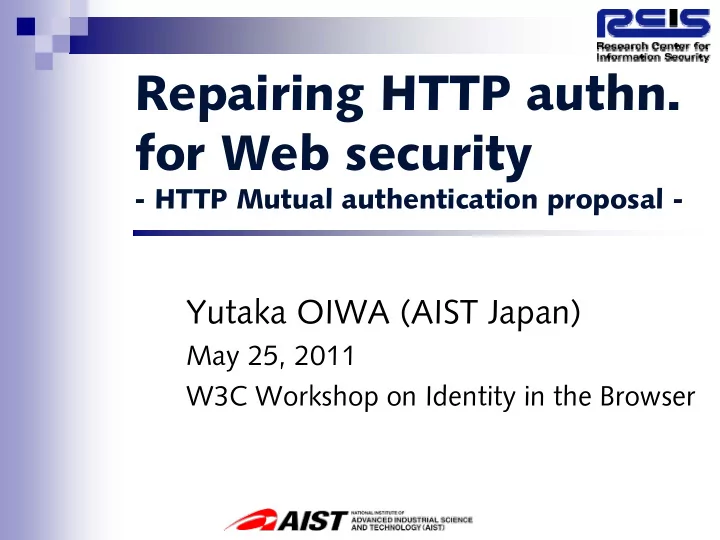

Repairing HTTP authn. for Web security - HTTP Mutual authentication proposal - Yutaka OIWA (AIST Japan) May 25, 2011 W3C Workshop on Identity in the Browser
Some Keywords yesterday and today… � You can't get there from here directly � Incremental adoption is important � “Phishing is fun and profitable” � Browsers should be an agent for user auth � Bi-directional (mutual) authentication desired
Problems so far (1) � Form auth is insecure against forging! � Web pages have 100%control of behavior � Webpage script has full access to inputs � No measures introducible against phishing – Even if we had a “secure password field”, phishers could always make a imitation using JavaScript � HTTP auth: (only) potentially better � Browser will have a full control of auth process � It could protect user’s passwords (e.g. Digest) � But…
Problems so far (2) � HTTP auth is currently useless! � It is insecure now… Basic and Digest � More over, lacks applicability… � ugly modal dialog � no logout, no guest access � no session management possible
Chicken and egg problem… � Little motivation to fix HTTP auth… � Because it is not used now � No motivation to use HTTP auth… � Because it is hard to use � Because it is as insecure as Form � We cannot fix Form auth…
So what we need? � We need to cut the Gordian knots � We must provide enough-Secure mechanisms to address existing security problems � We must, at the same time , provide enough useful mechanisms so that people can move to the new things
Our proposal � Password-based HTTP authentication which � Strongly protects the password from attackers � No eavesdropping, MITM, forwarding attack, etc. � Now “safe” to talk with Phishers! (no offline attack) � Provides mutual server-client authentication � Correct site & correct password � auth success – Phishing site || wrong password � auth failure � Users can make sure they talk to the “correct” site – “correct” := the site they have registered an account
To overcome “usability” problem � Support for recent Web application design � Non-modal authentication � Optional authentication � Guest users can be supported � Timed/server-initiated logout � log-on/log-off page redirection � Gradually release possible � Coexist with Form auth. during transition period
UI issues � Secure UI needed � To prevent password-stealing by imitation � Mutual auth result should be available to user � “Non-modal” UI proposed � UI in a non-content (browser-controlled) area � not interrupting user’s website experiences � Web site can design own log-in page – Except the input area itself � Guest page + login-UI is also possible
UI example � Only “requirements” described in spec � Each browser will have an own UI � Can be integrated with local identity managements � Some “coordination” between browsers may needed � like padlock/RSS UI
Possible use cases � As a stand-alone � Openly applicable to “any” website � Combined with ID management � With federated logins � Used for login to “initial” ID provider � Where “Phishing” will be a real problem
Our possible strategy Make HTTP auth Make HTTP auth secure useful Need time to standardize; let’s start now Standardization Browser support Server/app support Gradually adoption Can coexist with Form auth Happy future !? Major adoption + user’s adaption=
More resources � Our project homepage: https://www.rcis.aist.go.jp/special/MutualAuth/ � IETF standardization effort � Mailing list http-auth @ ietf.org � Need your assistance/involvement! � Draft: � Official: https://datatracker.ietf.org/drafts/draft-oiwa- http-mutualauth/ � Some preliminary drafts (before submission) may be on our homepage
Recommend
More recommend